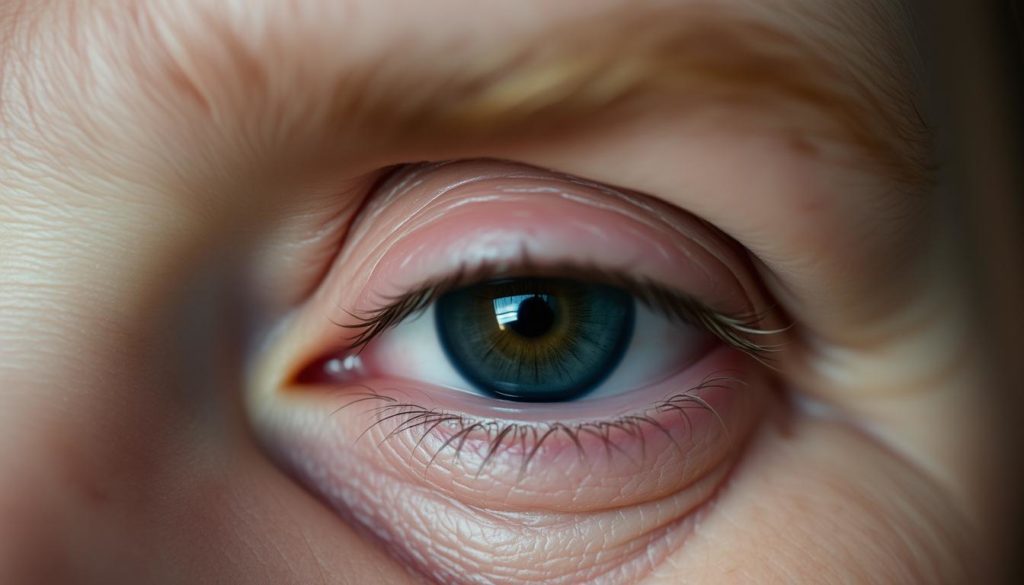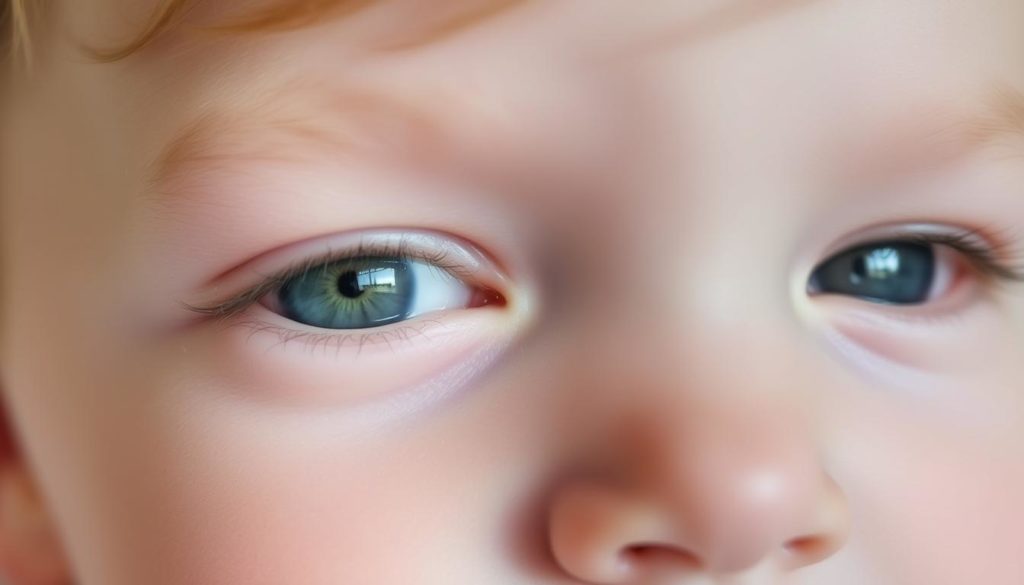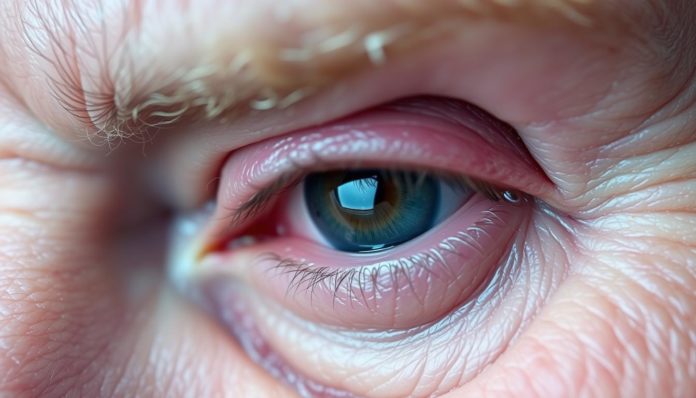About 5% of people have ptosis, a condition with drooping eyelids. This can greatly affect someone’s life and sight. Even though it usually doesn’t hurt, ptosis can lead to serious eye problems if not caught early. That’s why finding and treating ptosis right away is very important.
It’s key to know why eyelids droop, like muscle problems or nerve issues. Ptosis can be something you’re born with or get later. Finding the right treatment depends on the cause. Options vary from watching to see what happens to doing surgery.
Keep reading as we explore signs, types, reasons, and treatments for ptosis. We’ll make sure you have the facts you need to handle this condition well.
Understanding Ptosis (Droopy Eyelid) and Its Symptoms
Ptosis, often called droopy eyelid, is more than a beauty issue. Let’s explore the common ptosis symptoms. These symptoms can change how you go about your day.
Common Symptoms of Ptosis
Ptosis makes the upper eyelid droop. This can happen in one or both eyes. The drop may be slight or severe, sometimes covering the pupil.
Severe ptosis can lead to droopy eyelid vision obstruction. The eyelids might cover the pupil partly or fully, hurting your vision. To see better, some people tilt their heads back or lift their eyebrows.
How Ptosis Affects Vision
Ptosis impacts vision based on how bad it is. If the eyelid covers the pupil, it narrows your ptosis visual field. This makes everyday tasks like reading and driving tough. Even recognizing people becomes hard.
Some say they feel like they have to strain their eyes or forehead muscles to see clearly. This can become tiring after a while.

| Symptom | Effect on Vision |
|---|---|
| Visible drooping | May block the upper part of the visual field |
| Eyebrow raising | Temporary relief but can cause strain |
| Head tilting | Alters normal posture, may not fully restore vision |
| Severe drooping | Complete droopy eyelid vision obstruction |
Different Types of Ptosis
Ptosis is also known as a droopy eyelid. It can differ in cause and how it appears. Mainly, it falls into two groups: congenital and acquired. Knowing the specific eyelid ptosis types a patient has guides the treatment plan.
Congenital Ptosis
 Congenital eyelid ptosis is there from birth, often due to how the body forms. It usually comes from the levator muscle not developing right. This muscle opens the eyelid. Catching and treating it early is key to avoiding harm to vision or growth.
Congenital eyelid ptosis is there from birth, often due to how the body forms. It usually comes from the levator muscle not developing right. This muscle opens the eyelid. Catching and treating it early is key to avoiding harm to vision or growth.
Acquired Ptosis
Acquired ptosis develops as one gets older due to several reasons. Usual acquired ptosis causes are muscle or ligament weakening, nerve injury, or issues after surgery or illness. Fixing it often means tackling the root problem to restore eyelid function.
| Ptosis Type | Causes | Common Treatments |
|---|---|---|
| Congenital Ptosis | Improper muscle development | Surgical intervention, corrective lenses |
| Acquired Ptosis | Muscle/ligament weakness, nerve damage, surgeries, health conditions | Treating underlying cause, surgical options, physical therapy |
Common Causes of Ptosis
Ptosis can stem from several factors, each affecting how the eyelid works. Knowing these reasons can help find the best treatment.
Muscle Weakness
A main cause for ptosis is the muscle weakness that lifts the eyelid. This issue, known as Ptosis muscle weakness, makes it hard to fully open the eyes.
Nerve Damage
Nerve damage-related ptosis can happen from injuries or illnesses that harm the nerves for eyelid movement. This damage cuts off the brain’s commands to the eyelid muscles, leading to droopy eyelids.
Aging and Skin Looseness
As we age, our skin and muscles tend to get less tight, a situation often called ptosis aging effects. This issue is common in older folks, causing the skin and muscle to lose strength and stretchiness.
Diseases and Health Conditions
Some conditions, like diabetes, tumors, and stroke, can trigger ptosis. These health issues may directly or indirectly harm the eyelid’s muscles and nerves.
It’s important to understand the various causes of ptosis for proper diagnosis and planning the right treatment.
Diagnosing Ptosis
The process of diagnosing ptosis is detailed and careful. It strives to grasp the full scope of the condition and find out what’s causing it. A thorough evaluation is key to nail down the right diagnosis. This then leads to the most effective treatment options.
Physical Examination
The journey to diagnose ptosis begins with an in-depth eyelid drooping examination by an eye doctor. The doctor checks how the eyelids move, their position, and how they work. They measure how high the eyelid is and look for any unevenness. This step figures out how bad the ptosis is and its impact on seeing.
Diagnostic Tests
Along with the physical exam, several tests add more clarity. The slit-lamp test offers a close look at the eye’s inner parts. The Tensilon test can spot myasthenia gravis, often connected with ptosis. Checking the visual field is also crucial. It detects if the sagging eyelid is causing any sight loss.
| Diagnostic Method | Purpose |
|---|---|
| Slit-Lamp Examination | Detailed view of eye structures |
| Tensilon Test | Diagnose myasthenia gravis |
| Visual Field Testing | Check for vision loss |
Going through a thorough diagnostic process for ptosis helps ensure patients get treatment plans designed just for them. This boosts their odds of a better recovery.
Natural Measures and Home Remedies
Many people look for natural remedies for droopy eyelids as a way to tackle ptosis. These home-based methods can ease the condition and boost eye health. Let’s discover how these strategies can make a difference.
Eyelid exercises are a great way to strengthen the muscles around your eyes. You can raise your eyebrows or tap your eyelids to spark muscle action. Done regularly, these exercises might lessen ptosis.
There are also lifestyle changes that can help. Getting enough sleep and handling stress well works wonders for your eyes. Eating foods full of vitamins and minerals is key for muscle and skin health.
Use warm compresses as a ptosis home treatment to ease your muscle tension. Placing chamomile tea bags on your eyes is another helpful tip. These can soothe droopy eyelids.
- Performing specific eyelid exercises
- Maintaining a balanced diet
- Applying warm compresses
- Using herbal remedies
Let’s compare some ptosis care at home methods:
| Method | Benefit | Usage Frequency |
|---|---|---|
| Eyelid Exercises | Strengthens muscles | Daily |
| Warm Compresses | Relaxes muscles | Twice a day |
| Herbal Remedies | Reduces swelling | As needed |
| Balanced Diet | Improves overall eye health | Consistently |
Adding these natural methods to your daily life can help manage ptosis at home. While they can’t replace doctor’s advice or surgery, they are good, safe options. They offer a non-surgical way to deal with droopy eyelids.
Surgical Treatment Options for Ptosis
There are many surgical options for fixing ptosis. Each one is chosen based on what the patient needs. These surgeries can be for health or looks, focused on the person’s unique situation.
Blepharoplasty
Blepharoplasty is often used to correct ptosis. It gets rid of extra skin, muscle, and sometimes fat in the upper eyelids. This helps improve sight and makes the eyes look younger. For more info, visit NYU Langone Health.
Ptosis Surgery for Children
For kids, fixing ptosis early is key. It avoids problems like “lazy eye.” The surgery usually tightens a muscle to lift the eyelid. This helps the child see normally.
Risks and Recovery Process
Ptosis surgery has risks, like infection or anesthesia issues. After surgery, patients should take it easy. They should not touch their eyes much. Keeping eyes moist helps with healing. NYU Langone Health has more care tips after surgery.
Non-Surgical Treatments for Ptosis
If you don’t want surgery for ptosis, you have options. Eye exercises and glasses with a ptosis crutch can help. They improve how well your eyelids work without needing surgery.
Eye Exercises
Doing eye exercises can make your eyelid muscles stronger and more flexible. You’ll do simple movements like lifting and blinking gently. These can reduce ptosis effects over time.
Special Glasses with Ptosis Crutch
Glasses with a ptosis crutch have a special support for droopy eyelids. They lift your eyelids right away. This makes you see better and look better without any surgery.
| Treatment Option | Description | Benefits |
|---|---|---|
| Non-surgical ptosis correction | Includes eye exercises and ptosis crutch glasses | Enhanced eyelid muscle strength and immediate lifting effect |
| Eyelid exercise | Regular, gentle lifting and blinking exercises | Improves muscle flexibility and strength |
| Ptosis crutch glasses | Eyewear with a built-in mechanical lift | Provides immediate lifting of eyelids, enhancing vision |
Living with Ptosis
Dealing with ptosis means making smart changes to how you live. This can help you manage trouble seeing. People with ptosis may have to tilt their heads back to see well. They might use special glasses or do eye exercises often. Seeing eye doctors regularly is key to keep an eye on and handle the condition.
Also, it’s important to sort out any health issues that might cause droopy eyelids. Keeping a high quality of life with ptosis needs an active role in caring for your eyes. Going for check-ups often and following doctor’s advice can stop more eye problems. Surgery might be an option to better see and feel more comfortable.
For more details on treatments, both surgical and not, visit this helpful link. It gives you info on what you can do.
Having ptosis also means being part of a caring community. Talking to others who understand can give you emotional and handy advice. Online groups and local meet-ups are great for managing ptosis in everyday life. Knowing more about your condition and having people to talk to can really help with the ptosis challenges.
FAQ
What are the common symptoms of ptosis?
Ptosis makes the upper eyelids droop. It can happen in one or both eyes. People with ptosis might tilt their heads or lift their eyebrows to see better.
How does ptosis affect vision?
Ptosis can block part of your vision by covering the pupil. In serious cases, it might lead to poor vision or lazy eye, especially in kids.
What are the different types of ptosis?
There are two main types: congenital and acquired. Congenital ptosis is there from birth and often due to development issues. Acquired ptosis comes from nerve damage, muscle weakness, aging, or health issues like diabetes or stroke.
What are the common causes of ptosis?
Ptosis happens because of weak muscles, nerve damage, aging, and certain health problems. Some health issues that can lead to ptosis are diabetes, tumors, or having a stroke.
What does diagnosing ptosis involve?
To diagnose ptosis, doctors do a full exam. They might use special tests like the slit-lamp exam, Tensilon test, and checking your field of vision. This helps find the cause and the best treatment.
Are there any natural measures or home remedies for ptosis?
Trying non-invasive methods and home remedies may help with ptosis. Doing specific exercises can strengthen your eyelids. Changing some daily habits can also ease the symptoms.
What surgical treatment options are available for ptosis?
Surgery, like blepharoplasty, can fix ptosis if it’s really affecting vision. In kids, it can prevent lazy eye. Surgery typically tightens the eyelid muscle or removes extra skin. But, consider the risks and recovery time.
Are there non-surgical treatments for ptosis?
Yes, there are non-surgical choices. Exercising your eyelid muscles and special glasses with a ptosis crutch can help. These glasses lift the eyelids, improving vision for some people.
How can one adapt to daily life with ptosis?
Living with ptosis means finding ways to manage vision problems. See eye specialists often and take good care of your eyes. Making certain changes in your life can help you keep a good quality of life. Being part of a community and staying well-informed is helpful too.


